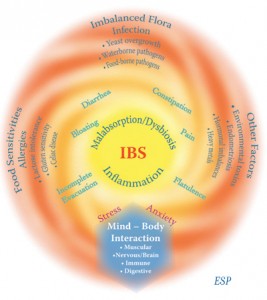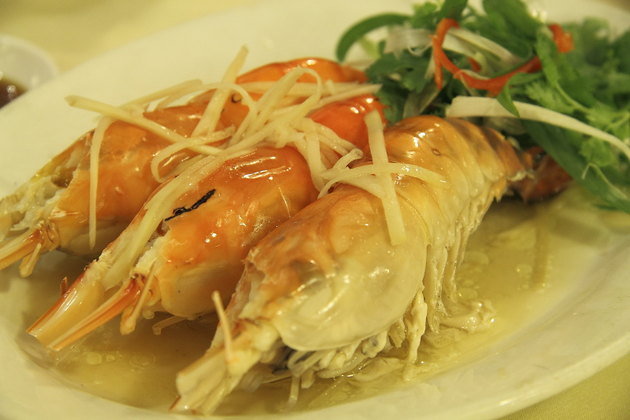Fresh Water Prawns
A patient of mine told me about freshwater prawns that are farmed here locally. “What a great idea!”, I said. All of us could benefit from this novel animal food since freshwater fish can be used by everyone regardless of their energy pattern. Freshwater fish will pacify everyone’s physiology and promote energetic balance Salt water seafood is potentially Pitta provoking so having a freshwater alternative sounded like a great alternative
Then I began thinking of possible problems. They’ll probably have a weird taste. “No”, my patient explained, “they taste even better than the saltwater prawns.” They’re probably hard to find, I thought. “And they are locally available just off Lake street.” My mindbody began searching for other possible reasons but having no more objections, I thought it wouldn’t be a bad idea to try them.
The next day I found myself ambitiously getting ready for my sojourn to the store to try this new found possible taste thrill. “Maybe I won’t have enough time,” I thought to myself. Nonsense, just go get them and if I don’t like them, my daughter will eat them.
So I get the prawns and they’re delicious! And now I noticed the same process that my mindbody goes through when confronted with something new. There is hesitancy about what might happen if I do something out of the ordinary. Something that’s not in my realm of comfort. I’ll have the saltwater prawns, thanks very much.
What gives? Why do I get so resistant to trying something new? I think the simple answer is the fear of the unknown. The uncertainty of predicting what lies ahead prevents us from moving off center and doing something different. For some the acceptance of change may be easy, for others it may be more difficult. And for all of us, there will be guaranteed issues that we balk at and say to ourselves, not today.
Freshwater prawns may be easy but perhaps changing our whole nutritional pattern may be something else. But the key to any change is realizing the fear and stepping through it. Everyone has their pet ways of resisting change. Predominant Vata people run away from fear, Pitta criticizes and becomes judgmental, justifying their resistance by talking themselves out of whatever they’re fearing to change. And Kapha simply resists by inertia-just not going to do it. A sense of complacency becomes overwhelming.
Knowing this resistance to the uncertainty and realizing that we will always express our resistance is unique ways allows us to watch ourselves in the midst of our resistance and perhaps walk through it. But if not, it’s OK. There will always be another day
Read More
Irritable Bowel Syndrome: An Energy Science Perspective
 Digestive fire is a collective term for all the enzyme and bacterial systems from mouth to anus So you can see it has broad connotations in terms of good bowel function and if abnormal potential for poor bowel function
Digestive fire is a collective term for all the enzyme and bacterial systems from mouth to anus So you can see it has broad connotations in terms of good bowel function and if abnormal potential for poor bowel function
From an energy science point of view irritable bowel syndrome(IBS) is a collection of bowel symptoms related to disturbed digestive fire or what Ayurveda terms agni As I have written in the past most people's agni is not up to par The reason for this is quite simple The concept of agni is not even in our health vocabulary
How would you know about it and hence take care of it if you don't know it exists?
This is a significant problem for the present day health consumer but unfortunately she is duped by the matter science model into believing it is complete Suffice it to say the majority of the population suffers from symptoms of IBS
The Symptoms of IBS
The types of IBS fall into four categories: Vata Pitta Kapha and combination patterns By far and away the latter makes up the majority of those affected by symptoms The most common symptom of IBS is bloating after eating for short or extended periods of time
Many people don't know that they bloat and some who have an exaggerated bloat know it very well Abdominal distention occurs as a result of the gaseous bowel distention Other symptoms include diarrhea, constipation, or a mixture of diarrhea and constipation At times flatulence or excessive gas that may be malodorous may occur
When the Kapha energy pattern is manifested in large degree mucous will be present in the stools but the worst IBS of all is when the mucous becomes dried in the GI tract This creates a marked problem for elimination This latter group of IBS can become severely debilitated professionally, physically, and often emotionally drained due to the chronicity of the disease This is the ultimate in the manifestation of IBS and the matter science has little to offer in such cases
The Creation of Ama
Now the stage is set for the next phase of disease Agni becomes impaired and due to this undigested food begins to accumulate in the GI tract The energy science of Ayurveda terms this ama(not to be confused with the American Medical Association)
This ama begins to clogs the lymphatics of the bowel wall leading to malabsorption, food intolerances(aka allergies), and "overgrowth syndromes"(yeast etc), and in children the autism spectrum disorder As a matter of fact we could simply do fill ama would be part of the disease
In essence IBS goes together with almost all diseases except for perhaps trauma The bowel dysfunction related to disturbed agni is fundamental to the unfolding causative process of every disease in the mindbody even mental disease
Energeticall vibrational frequencies begin to accumulate in the GI tract and then spread to different partsof the mindbody to promote mischief
Treating IBS
So treating any disease requires that IBS is treated as well According to posts there are essentially two levels of therapy for any energetic imbalance in the mindbody The first level is to stop the condition from getting any worse The second level is to remove the offending vibrational frequencies using specific therapeutic modalites that have already been discussed
But one of the integral therapies in IBS treatment is to deal with the cause of the problem.....disturbed agni This is paramount to successful management and since the matter science doesn't even have the concept all bets are off that IBS management will be successful
Many many of the blog posts done in the past have made suggestions about how to promote better agni CCF tea, agni tea, ginger tea are all about promoting better balanced agni Herbs can be very impactful in this regard and it's beyond the scope of this dialogue today to address them
Using a nutritional format appropriate for your energy constitution and avoiding incompatible food combinations can be very helpful in not aggravating the condition In this regard the daily use of churans as talked about in the past is very advantageous
A specific pranayama(breathing exercises) flow sequence can really help impaired disturbed agni by balancing it Dependent on the severity of the IBS other methods can be employed And yoga asana practice has been successfully employed in the matter science literature
As in all energy work however it's not just one thing that creates healing....healing requires a multifaceted approach to bring about real healing
Read More
Nutrition Bad Habits: Snacking and Overeating
 Digestive strength as I've talked about in the past is called agni(we get our word ignite from this word) and it's said that if you have a strong agni you will live a long and healthy life The converse is also true If you have poor agni you will create disease for yourself So taking care of your agni is paramount to good health
Digestive strength as I've talked about in the past is called agni(we get our word ignite from this word) and it's said that if you have a strong agni you will live a long and healthy life The converse is also true If you have poor agni you will create disease for yourself So taking care of your agni is paramount to good health
How Does Agni Affect Heath?
If poor agni exists then there is residue due to incomplete digestion The metaphor of a campfire is often used If the campfire is robust and good wood(food that is appropriate for your energy constitutional makeup) then what's left when the fire is out is fine ash All the nutrients have been harvested
But what about a poor campfire? The result is charred wood that has been ineffectively digested by the fire In the energy science terminology in the gut the result is ama or undigested food This undigested food clogs the lymphatic channels and sets up the possibility of being disseminated to the rest of the body
Snacking
Eating in between meals affects agni by overutilizing it.....the gut's enzyme system is busy digesting the last meal But then the choicemaker(that's you) makes the choice to eat ............(fill in the blank) Now the agni has incompletely burned the meal and has to turn around and digest the snack
A vicious cycle is set up where the digestion is never complete....hence the result is ama Not good The solution to snacking is not easy because it's an addictive habit especially in the work environment But with resolve it can be overcome like any addiction Creating more balance will ultimately stop the snacking because the body will send signals of rebellion
Overeating
When we overwhelm even a good digestive fire by loading the stomach up too much(defined as what you can hold in the palms of your two hands) then it's like putting wet logs or too many logs on your campfire The result is charred remains or in energy science lingo ama Now this amount of how much to eat can vary from individual to individual because of many variables including exercise which puts more demand on agni
But I think it's fair to say that everyone will know when they have overeaten due to the sensation in the stomach The remedy for overeating is simple Fasting until you're really hungry for the next food
Read More
5 Herbal Rejuvenatives for the Mind and Memory
 As our population ages, declining mental faculties can take first place on the list of one’s health concerns. Alzheimer's disease and other forms of senile dementia affect some 25 percent of all people over 80.1 Research, though, is revealing Ayurvedic approaches in helping to support the natural strength of the mental faculties.
As our population ages, declining mental faculties can take first place on the list of one’s health concerns. Alzheimer's disease and other forms of senile dementia affect some 25 percent of all people over 80.1 Research, though, is revealing Ayurvedic approaches in helping to support the natural strength of the mental faculties.
Mental Rejuvenation with Ayurveda
Medhya is an Ayurvedic concept that implies intellect, or wisdom. Medhya remedies promote mental development and act as mental rejuvenatives, and they also suggest a mind that is mighty, vigorous and pure.
There are many ways to bring medhya into play in the mind. Anything that promotes the sattva guna can help in our quest, and the yamas and niyamas of Patanjali are aimed at this. Ayurvedic herbal medicines also play a role. They engender and summon intelligence, memory and mental perception. They make the mind worthy of sacrifice to higher consciousness.
Bitter taste is made from air and space energies, and these forces predominate in the mind. Bitter foods and herbs open the mind, increase sensitivity, awareness and mental functioning. Since bitter herbs are cooling and calming they combat mental dullness, allowing us to reach our full potential, becoming radiant and elevated.
Mind supplements include a large array of herbs and foods recommended to rebuild body tissues and restore lubricating juices.2 Five of these mind-nourishing herbs stand out as pillars of an Ayurvedic lifestyle.
Ashwagandha
Ashwagandha, sometimes named “winter cherry” or “Withania”, is a top mental rejuvenator. Ayurvedic herbalists use the herb to reestablish long-term sleep rhythms. Ayurvedic herbalism also uses ashwagandha for general strength for support in times of occasional fatigue and exhaustion; and to support healthy memory and a strong nervous system.
This tonic herb, a relative of tomatoes and potatoes, is not stimulating, but rather relaxing. That allows one to use this in larger amounts on a regular basis without concern for overstimulation, so this root is a superb remedy for nervous system support.
Study after study continues to confirm the benefits of this herb on stress tolerance, performance and endurance.3,4,5 One study indicated that the herb supported the brain in times of stress.6 In another, ashwagandha was shown to support strength and physical working capacity.7,8
Ayurveda considers it a “grounding” herb, one that nourishes and regulates metabolic processes and supports a naturally balanced mood. Ashwagandha also supports memory, helping those such as students for whom learning and testing are priorities.9 One recent study looked at sleep and stress. Ashwagandha was effective in supporting naturally healthy sleep patterns.10
As well as being a slow-acting tonic herb, ashwagandha is a superb herb for balancing elevated vata, a common problem as age advances. It takes about a week to work up to an appropriate amount, and about another week for the herb to reach maximum effectiveness. Since ashwagandha is a slow-acting herb, you may take your daily serving at any time during the day.
A typical serving of ashwagandha is about a gram per day, taken over long periods, up to many years, as a rejuvenator, but, since ashwaganda is very safe, larger quantities are often used short term. In India, Withania is given with pungent, heating herbs (ginger, pepper, etc.) to ensure that it gets sufficiently digested.
Calamus
Conscious communication is the essence of yoga. From your chakras to your nervous system to the words you speak, your very molecules are vibrating with the energy of your being, and transmitting that energy to all the other parts of our bodies and to people in your life.
Yoga exercises, pranayama and lifestyle practices all support conscious communication, and there is one special herb that yoga reveres above all others for clarifying and expanding that special spiritual voice we all share.
Calamus root is a major herb for the mind and meditation, and is highly revered by yogis. Though it is not clearly allowed for internal consumption in the US, it can be used topically, either as a dry powder, paste, or as part of an herbalized oil. As a historical and international perspective, ancient yogis and seers used this herb, and it was said to stimulate the power of self-expression and to enhance intelligence. Calamus historically was used to promote a healthy brain, sharpen memory, enhance awareness and increase communication and self-expression. The yogic name, Vacha, means “speech”, referring to its action on the fifth chakra and is propensity to help you speak from your highest consciousness.
This herb was often combined with gotu kola, which is cooling and mild. The complementary energetics made the combination suitable for a wide variety of people. To support attention and focus, it was combined with gotu kola, shankpushpi and licorice. Over the long term, calamus warms the body and pacifies the mind. Vacha was also combined with triphala as a general rejuvenative that bestows intelligence, longevity and good memory.11
Vacha has a long and very special history in Ayurveda. For meditating yogis, it was quite a boost.
Brahmi (Gotu Kola)
Thinking about thinking? Feel like you’re about to max out your personal hard drive? Gotu kola is an herb with a long history of brain support. Gotu kola, also called Mandukaparni, is a mainstay of herbal medicine in Ayurveda. Widely considered a superior herb for the nervous system, gotu kola has a host of benefits.12
In Ayurvedic medicine, this herb is called “brahmi”, which means “godlike”, a reference to its support of graceful aging and to its use as an aid to meditation. It has a bitter taste and is cooling to the body.
Gotu kola supports healthy memory, concentration and intelligence, as well as the voice, physical strength and the complexion.
Gotu kola is a jungle creeper that grows in hot moist climates. After all, it’s the food of the elephants, and we all know about their memories! Fresh, it’s a delicious salad vegetable. The juice of the fresh leaves is available at some juice bars.
More recently, a study out of Korea shows that components in gotu kola show potential for supporting healthy memory, a very promising direction.13
Since gotu kola is basically a mild salad vegetable, the serving can be a larger quantity. Try one to four teaspoonfuls of fresh juice every morning. Many people use a modest amount of 1 gram per day in capsules or tablets for daily rejuvenation. Try a cup of gotu kola tea with honey before meditation.
Brahmi (Bacopa)
Water hyssop (Bacopa monniera), also refered to as brahmi in certain parts of India, is a steadfast mainstay of traditional Ayurvedic medicine. An indication of the respect for this herb is the name: “brahmi” means “god-like”. It’s used in Asia for support of the nervous system, mental energy, and healthy memory—it’s a powerful brain food. Meditators use it to increase comprehension, concentration and recollection. Because it traditionally supports a person’s natural ability to solve problems effectively, it is often found in Ayurvedic formulas to cope with stress.
With nearly 300 studies in the scientific literature, it has built up a solid base of scientific support for its many functions.
In support of the traditional use for promoting healthy memory, Australian researchers recently gave Bacopa to seventy-six adults, aged 40 to 65 years, in a double-blind randomized, placebo control study in which various memory functions were tested. Numerous memory tests before and after taking the brahmi showed that the herb significantly supported the learning process.14
Brahmi has traditionally been used for children as well. Indian schoolchildren take it at home. In 1987, Indian scientists gave brahmi to 40 schoolchildren aged 6-8 in a single-blind trial. The study showed support of learning, memory and perception. The dose was 1 gram per day for three months, of the dried plant extracted into a syrup form, and no side effects were recorded.15
The traditional serving can be up to two grams of the whole herb, in capsules, tablets or tea, twice a day with warm water.
Shankhapushpi
When we need mental peace and sleep, we may call upon shankhapushi to help restore clear quality of the mind and relaxation. Its flowers resemble the shankha or conch shell, thus the name. It usually is a foot tall plant, with dome of flowers, in open fields in North India.
This herb is an outstanding rejuvenative tonic for the mind and nerve tissue. The plant is said to have profound mystical properties, with an affinity for the heart, throat, third eye and crown chakras.
The herb is especially effective for mental peace and tranquility. Often taken with or prepared in ghee, it promotes serenity without dulling the mind. As it is balancing, its effect can be both uplifting and calming. Students traditionally use it to support a calm mind during exams. For support of focus and attention, it combines well with brahmi and licorice. For support of healthy sleep patterns, use shankpushpi at bedtime (traditional use allows for up to 6 grams). According to the Astanga Hridyam, ghee, cooked three times with shankpushpi juice and milk, makes even the dullest mind sharp.
Ayurveda places special attention on the health of the mind, and fundamentally teaches that, ultimately, all physical imbalances start in the mind, so a healthy mind is at the forefront of Ayurvedic practices. These five herbs form the core of a superb mental rejuvenative chest. They are waiting to help us stay calm, centered, intelligent and exalted, so now might just be the time to give this collection of herbs a try.
Karta Purkh Singh Khalsa
Karta Purkh Singh Khalsa is the lead instructor of the nutritional therapy and professional herbalist training programs at Portland Community College, where students pursue their credential online or in classrooms study, and on the founding faculty of Bastyr University Department of Ayurvedic Sciences. Khalsa is the President of the American Herbalists Guild and on the board of directors of the National Ayurvedic Medical Association. He is the first person to be board certified in herbalism and Ayurveda.
http://www.pcc.edu/climb/health/
http://www.kpkhalsa.com/
http://www.internationalintegrative.com/
References
Jill Stansbury, N.D., Sustain the Brain, Nutrition Science News, February, 2001, http://www.healthwellexchange.com/
Sharma, Ram, and Dash, Bhagwan, Caraka Samhita, Chowkhamba, Varanasi, 1992
Archana R, Namasivayam A. Antistressor effect of Withania somnifera. J Ethnopharmacol 1999 Jan;64(1):91-3
Singh B, Saxena AK, Chandan BK, Gupta DK, Bhutani KK, Anand KK. Adaptogenic activity of a novel, withanolide-free aqueous fraction from the roots of Withania somnifera Dun. Phytother Res 2001 Jun;15(4):311-318
Venkatraghavan S, et al, J Res Ayu Sid, 1, 1980:370. [from: Bone K, “Withania somnifera”, Clinical Applications of Ayurvedic and Chinese Herbs, (Queensland, Australia: Phytotherapy Press), 1996:137-41.]
Jain S, Shukla SD, Sharma K, Bhatnagar M. Neuroprotective Effects of Withania somnifera Dunn. in Hippocampal Sub-regions of Female Albino Rat. Phytother Res 2001 Sep;15(6):544-548
Dhuley JN. Adaptogenic and cardioprotective action of ashwagandha in rats and frogs. J Ethnopharmacol 2000 Apr;70(1):57-63
Bhattacharya SK, Bhattacharya A, Chakrabarti A. Adaptogenic activity of Siotone, a polyherbal formulation of Ayurvedic rasayanas. Indian J Exp Biol 2000 Feb;38(2):119-28
Dhuley JN. Nootropic-like effect of ashwagandha (Withania somnifera L.) in mice. Phytother Res 2001 Sep;15(6):524-528
Kumar A, Kalonia H. Effect of Withania somnifera on Sleep-Wake Cycle in Sleep-Disturbed Rats: Possible GABAergic Mechanism. Indian J Pharm Sci. 2008 Nov;70(6):806-10.
Srikantha Murthy, K.R. Vagbhata’s Astanga Hrdayam. vol. 3. Varanasi: Krishnadas Academy. 1995. p. 387
Vaidya, Ashok D.B. The Status And Scope Of Indian Medicinal Plants Acting On Central Nervous System. Indian J Pharmacol 1997; 29: S340-S343
Mook-Jung I, Shin JE, Yun SH, Huh K, Koh JY, Park HK, Jew SS, Jung MW. Protective effects of asiaticoside derivatives against beta-amyloid neurotoxicity. J Neurosci Res 1999; Nov 1;58(3):417-25
Roodenrys S1, Booth D, Bulzomi S, Phipps A, Micallef C, Smoker J . Chronic effects of Brahmi (Bacopa monnieri) on human memory. Neuropsychopharmacology. 2002 Aug;27(2):279-81
Sharma R, Chaturvedi C, Tewari PV. Efficacy of Bacopa monniera in revitalizing intellectual functions in children. J Res Edu Indian Med. 1987;1:12
Read More
Cold Hands Cold Feet
 I was driving into the office the other day and became aware of cold hands. They had been warm before I had left the house so there had been a change. "What's going on," I asked myself, but of course I knew that I had made this observation in the past.
I was driving into the office the other day and became aware of cold hands. They had been warm before I had left the house so there had been a change. "What's going on," I asked myself, but of course I knew that I had made this observation in the past.
But this time I began to put it together. As we have discussed in previous blog posts, the biological energy field expresses itself through qualities of sensation. There are 10 biological pairs of sensation. For example, the sensations of hot and cold, light and heavy, subtle and gross are examples of these paired potential sensations.
We can only know the energy body through sensations in the mindbody. So when I felt the cold hands it occurred to me that the biological energy pattern of Vata, the priniciple of movement in the physiology, must be being aggravated. It was subtle but real and a tip off to slow down and breath. When we get into a rush, we invoke the sympathetic nervous system and from a matter field perspective, we vasoconstrict and this reduces blood flow to the hands.
From an energy perspective, the energy field was sending me a signal to slow down and breath which would activate the parasympathetic nervous system and restore balance in the energy physiology.
Foods can produce the same shifts in the energy mindbody. Have you ever felt hot after eating a very spicy meal? This is yet another message from the energy field. All we have to do is pay attention.
To good health DrBill
Read More





